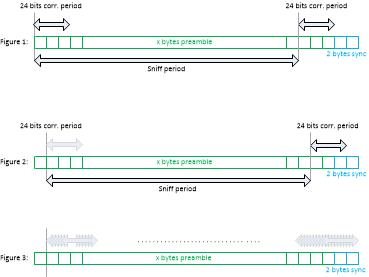Hi,
in the WakeOnRadioRx example (last TI RTOS) we see the following note about Correlation Period:
Correlation Period
The correlation period is the time window in which the radio have to have detected a valid preamble. This time window will be moved forward for every valid PQT detected, which is done in the underlying hardware via correlation peaks, hence the name. The very first peak will happen after about 24 symbols of preamble has been received. Subsequent peaks will happen every two symbols. If there is no correlation peak within the Correlation Period, then there is no valid preamble on the air.
One caveat of this period is that it has to be both wide enough to get the very first correlation peak. Another is that it also has to be wide enough to be able to fit the entire sync word, with some margin. The reason for this is because if it is not, then the command will report back that it can no longer sense preamble as it is receiving the sync word.
I don't understand the meaning of the two last phrases.
Q: Why the correlation period should be wide enough to be able to fit the entire sync word?
BR
Leonid


